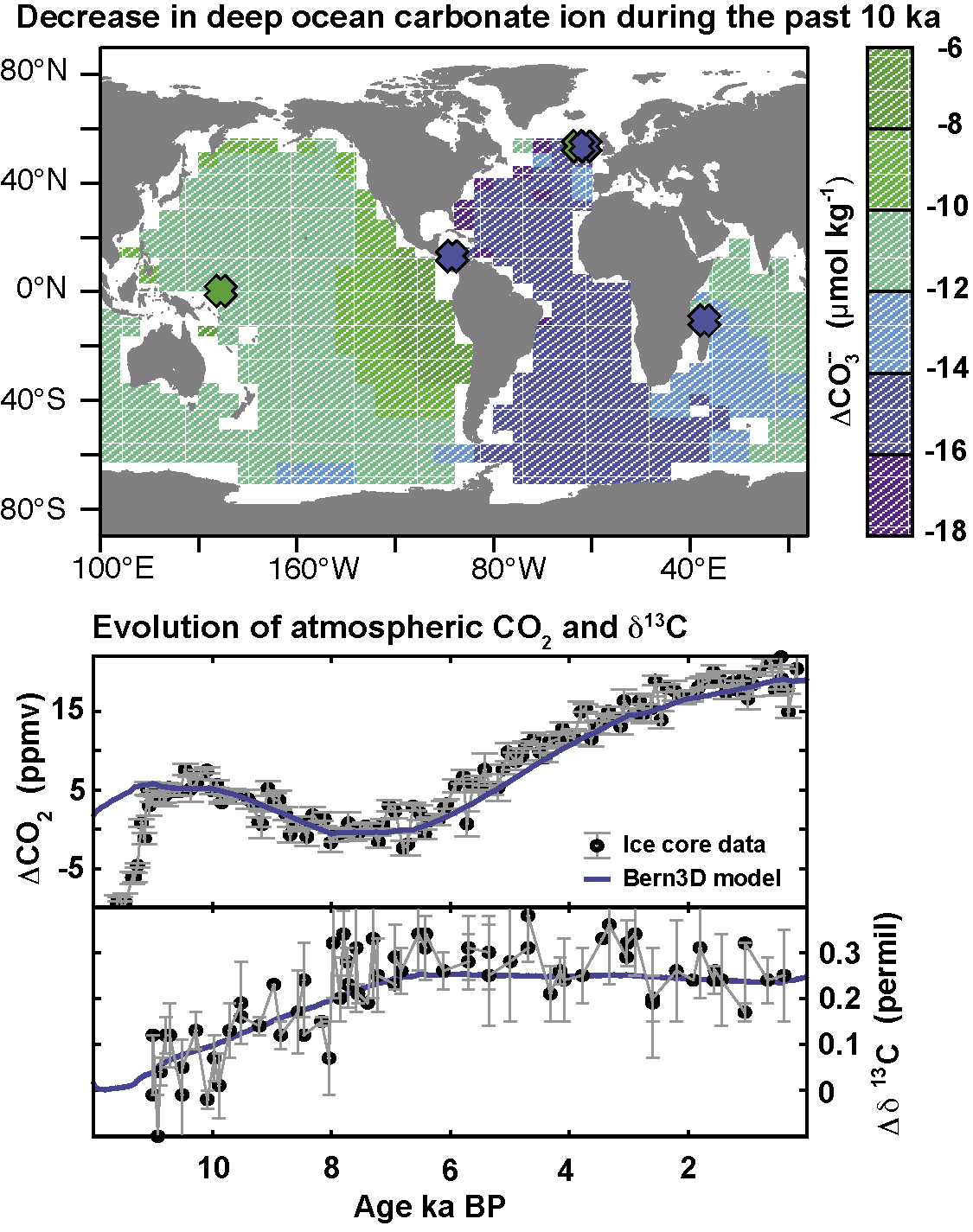- Home
- Publications
- PAGES Magazine
- Carbon Cycle Dynamics - How Are Major Carbon Sinks and Sources Varying With Global Change? [Past]
Carbon cycle dynamics - How are major carbon sinks and sources varying with global change? [Past]
Fortunat Joos
PAGES news
20(1)
13
2012
Fortunat Joos
Climate and Environmental Physics and Oeschger Centre for Climate Change Research, University of Bern, Switzerland; show mail address
Paleoclimate data are essential to gauge the magnitude and the speed of change in greenhouse gas concentrations, ocean acidification, and climate. These parameters co-determine the anthropogenic impacts on natural and socioeconomic systems and their capabilities to adapt.
Concentrations of the three major anthropogenic greenhouse gases were much smaller during at least the last 800 ka than modern and projected concentrations. The ice core record reveals that the average rate of increase in CO2 and the radiative forcing from the combination of CO2, CH4, and N2O occurred by more than an order of magnitude faster during the Industrial Era than during any comparable period of at least the past 16 ka (Joos and Spahni 2008). This implies that current global climate change and ocean acidification is progressing at a speed that is unprecedented at least since the agricultural period.
Ice, terrestrial and oceanic records reveal huge changes in climate during glacial periods on the decadal time scale (Jansen et al. 2007). These are linked to major reorganizations of the oceanic and atmospheric circulations, including a stop and go of the poleward Atlantic heat transport and shifts in the rain belt of the Inter Tropical Convergence Zone (ITCZ). These ”Dansgaard-Oeschger” and related Southern Hemisphere climate swings demonstrate that the climate system can switch into new states within decades – a potential for unpleasant future surprise.
Surprisingly, variations in atmospheric CO2 remained quite small during Dansgaard-Oeschger events. This indicates a certain insensitivity of atmospheric CO2 to shifts in the ITCZ, changes in the ocean’s overturning circulation, and abrupt warming of the boreal zone. Related variations in N2O and CH4 are substantial (Schilt et al. 2010), but the resulting radiative forcing is several times smaller than current anthropogenic forcing. Greenhouse gas concentrations react to climate change and amplify it, but the data may also indicate that such an amplification of man-made climate change may remain moderate compared to anthropogenic emissions. This is in line with results from Earth System Models and probabilistic analyses of the last millennium temperature and CO2 records (Frank et al. 2010).
Theories and Earth system models must undergo the reality check to quantitatively explain the observations. For example, reconstructed and simulated spatio-temporal evolution of C-cycle parameters during the last 11 ka (Fig. 1) provide evidence that the millennial-scale CO2 variations during the Holocene are primarily governed by natural processes (Menviel and Joos 2012), in contrast to previous claims of anthropogenic causes.
Paleoscience allows us to test hypothesis. Can we mitigate the man-made CO2 increase by stimulating marine productivity and promoting an ocean carbon sink by artificial iron fertilization? Paleodata (Röthlisberger et al. 2004) and modeling suggest that we can’t – past variations in aeolian iron input are not coupled to large atmospheric CO2 changes.
Warming might set carbon free from permafrost and peat or CH4 currently caged in clathrates in sediments, which would in turn amplify global warming and ocean acidification. However, soil, atmospheric CO2 and carbon isotope data suggest a carbon sink, and not a source, in peatlands during periods of past warming (Yu 2010). Likewise, ice core data show no extraordinarily large CH4 variations nor supporting isotopic signatures (Bock et al. 2010) for thermodynamic conditions potentially favoring CH4 release from clathrates, i.e. during periods of rapid warming and sea level rise.
Yet, it is not always clear to which extent a comparison of the past with man-made climate change is viable. We need to improve our mechanistic understanding of the underlying processes to better assess the risk of ongoing greenhouse gas release and associated climate amplification and feedbacks in order to better guide emission mitigation and climate adaptation efforts. Paleoresearch, offering unique access to time scales and complex climate variations neither covered in the instrumental records nor accessible by laboratory studies, is the key to reach this policy-relevant goal, but its potential has barely been exploited.
selected references
Full reference list online under: http://pastglobalchanges.org/products/newsletters/ref2012_1.pdf
Frank DC et al. (2010) Nature 463: 527-530
Menviel L and Joos F (2012) Paleoceanography 27(1), doi: 10.1029/2011PA002224
Röthlisberger R et al. (2004) Geophysical Research Letters 31, doi: 10.1029/2004GL020338
Schilt A et al. (2010) Quaternary Science Reviews 29(1-2): 182-192
